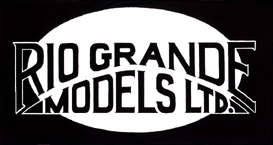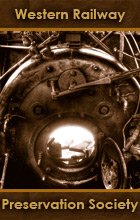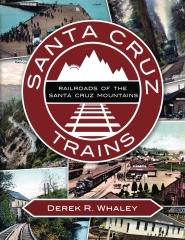

State Harbor Belt Railroad.
By Dave EgglestonF or over 100 years beginning in 1890, the San Francisco waterfront was home to the State Harbor Belt Railroad. For the first 20 of those years, from 1890 to 1910, the line was 3-rail, servicing both standard gauge (Southern Pacific, San Francisco & North Pacific and Atchison, Topeka & Santa Fe) and narrow gauge railroads (North Pacific Coast/North Shore/Northwestern Pacific and the South Pacific Coast). And during the dual gauge period the railroad had no physical connection with other any railroad; all cars arriving in San Francisco were ferried in.
San Francisco sits on the northeast end of a long peninsula with a ridge of coastal hills running north-south. The reality of the San Francisco Bay area geography is that only one good rail routes into the City exists. That route was first taken by San Francisco & San Jose in the early 1860s and the Southern Pacific absorbing the SF&SJ a few years later effectively locked any other railroad from direct City access.
Further compounding things was the nature of the San Francisco waterfront. From 1849 the need for space, especially flat space, resulted in ongoing fill operations that pushed the City east into the Bay block by block. The process had no real plan and resulted in a very convoluted, jumbled manner with no central planning. A bird’s eye view map of the City from 1877 clearly shows this mess of docks and warehouses zigzagging northward across the waterfront.
The situation limited San Francisco’s ability to handle the growing sea commerce. To bring control to the mess in the late 1860s the State Harbor Commission was given control for the future construction and development of the wharves and the design of a formal seawall under a logical plan. Their mission was to implement infrastructure that would grow commerce in the City. As early as 1872 the Commission considered a railroad along the wharves to move traffic efficiently; the lack of space stalled the plan. In 1879 seawall construction began and would continue in sections, heading north, for almost 20 years. This not only organized the wharves and shipping, it slowly created more open land north of the Ferry House, from Market Street around North Beach. A major thoroughfare, East Street, paralleled the seawall, slowly growing northward through the 1880s.
Even before the seawall construction more railroads were being built around the Bay. And in 1875 the North Pacific Coast floated the first narrow gauge cars to San Francisco. The NPC used a barge and tugs to move to make the runs between Saucelito 1 and the City. No evidence has yet come to light that the line had a ferry slip to land cars. And given the lack of open land at that time it’s highly unlikely. They initially were using wharves at the north end of the City but over the years moved south, ending at Clay Street by at least 1888. The cars were likely unloaded while still on the barges; freight came ashore by hand, crane or lighter. The NPC appears to initially have used the Powell Street wharf but by 1889 slowly migrated south to the wharf at Clay Street adjacent to the Ferry House.
In 1880-81 the SPC joined the party, floating cars from Alameda. A freight house and ferry slip were built immediately south of the Ferry House for this traffic. Unlike the NPC, the SPC moved cars onto land and there was a small team yard that had at least two tracks, and maybe more. Horses likely pulled the cars.
The narrow gauge lines were able to get their freight into the City using cars but the landings were far from ideal. The SPC’s tracks only added to the clutter around the Ferry House, a source of headache for everyone. And other rail lines wanted in and there was little room for expansion until the seawall had progressed to Lombard Street. Beginning 1888 the voices calling for improvements led to the Harbor Commission developing a plan in 1890 to create a rail operation along East Street, fed by ferries. It would be known as the State Harbor Belt Railroad and funded, built and operated by the State. The line would be 3-rail to support both narrow and standard gauge cars.
Construction began in 1891. The line ran north up East Street (present day Embarcadero) from Vallejo Street, just north of the Ferry House, to Francisco Street. A single freight ferry slip was built at Lombard Street, facing southeast into the Bay. A main transfer yard was constructed on the blocks bounded by Vallejo, Front, Union and East—for use by the SF&NP and the SPC, the two lines using the rail facility from the start. A Baldwin 2-4-2 standard gauge engine named “Gov. Markham” was kept in a frame engine house at Lombard Street. At this time there were no private or industrial spurs.
The NPC began to start using the line very soon after opening and a small yard for its exclusive use was built at Lombard Street. A picture can be seen in Bruce MacGregor’s “Birth of California Narrow Gauge” on page 239.
At first the engine was the line’s only piece of equipment. Concerns mounted over the engine’s running down the ferry slip to move cars. Serious listing of the slip/ferry connection made it clear to everyone but the line’s management that serious damage were just a matter of time. Enough complaints led to the purchasing of two idler flat cars.
The line was a success from the start and in 1892 it was extended north to Powell Street to reach the extensive lumberyards in the area (Simpson, DH Bibb, and Bellingham Bay were three of many using the new flats created by the seawall). A growing bottleneck at the slips had also become apparent and a second ferry slip was alongside the first. A cattle spur was also pushed out on the slip’s wing.
All evidence found to date indicates that until 1901 the Harbor Belt ran with just the one loco, serviced by the SF&NP or the SP when necessary, with leased locos from those lines used during servicing times. No evidence has surfaced of a narrow gauge engine be used during this time. Operations were simple: Move specific railroad’s cars in blocks between the yards and the ferries at specific times on specific days of the week. In addition a lot of team traffic appears to have been offloaded from cars parked on the East Street “main” where cars were also stored off-spot awaiting movement to the transfer yards or ferries.
A frequent question is whether the SPC and NPC interchanged cars via the Belt. There is no conclusive evidence of the narrow gauges interchanging cars via the Belt, nor did the line operate using narrow gauge engines. There have been some later photos reported of SP narrow gauge cars on the NWP but in 1906 the NWP purchased 150 ex-SPC cars, which could be what was captured on film.
San Francisco was the largest West Coast port well into the 20th century. Traffic into the City only grew through the 1890s. The increasing open space in North Beach thanks to the seawall construction brought new businesses creating a vibrant industrial district. All of this activity increasingly stressed the wharves and the Harbor Belt: A major overhaul to was needed. From 1899 to 1901 the Harbor Commission made some important changes:
- The Lombard ferry slips were rebuilt to face northeast which reduced the impact of the ferry traffic on the wharves and fisherman’s terminal;
- The SP was granted a yard in the block bounded by Pacific, Vallejo, Davis and East, marking the start of their using the Harbor Belt. This yard was not dual gauge;
- The AT&SF arrived in the East Bay in 1899 and had built a small isolated float yard near Mission Bay. Within a year the Santa Fe was convinced to use the Harbor Belt and a yard was put in for their float traffic between Chestnut and Francisco Streets below Montgomery, north of the slips. This yard was not dual gauge;
- The Harbor Commission began to grant private spurs for shippers in 1899 and within 5 years a dozen of these would branch off of East Street and along North Point Street, becoming major revenue generators for the line. All of these were at least standard gauge and many were 3-rail.
These changes along with improving the wharves led to efficiencies benefiting the City commerce. Incoming car float traffic dramatically increased and the Harbor Belt kept it moving. The few surviving pre-earthquake records show how busy things were between 1900 and 1904: The SPC shipped on average 500 cars a month to the City, and the NPC shipped on average 200. It’s not surprising that the Belt purchased a second Baldwin engine in 1901, a 2-4-2, and a third, identical, engine in 1904. An additional stall and extension to the original frame engine house were constructed when the second engine arrived.
The booming commerce began to affect the rail scene, too. The NPC became the North Shore in 1902 and continued to ship narrow gauge cars to the City. The SPC had been under SP control for 15 years by 1901 and their growing traffic made it clear conversion to standard gauge was needed. The process of widening the SPC line between Alameda and Santa Cruz continued into 1906.
Then the earthquake hit. Much of North Beach was destroyed in the fires following the quake and at least two photos near Lombard Street show East Street subsided with the tracks badly damaged a line of NPC combination boxcars partially derailed. The engine house and freight slips survived and the line was back in operation within a month, used heavily during reconstruction of the City. Out of this calamity came another opportunity for the Harbor Commission to completely redesign the waterfront. New wharves along the entire waterfront and a very upgraded Harbor Belt were the keys to this redesign.
Following the quake a change in the narrow gauge scene also began to unfold. The SP quickly ceased shipping narrow gauge cars into the City, finishing the plan they’d started before the quake. The North Shore continued shipping but as it was restructured into the Northwestern Pacific in 1907 the end of narrow gauge floats was becoming apparent. Letters at this time show the Harbor Belt and NWP were discussing the removal of 3-rail. Finally in 1909 the NWP ceased floating narrow gauge cars from Sausalito. The narrow gauge cars freight was transshipped into standard gauge cars in San Anselmo and these cars were floated from Tiburon to the City. When the last narrow gauge car ran on the Belt is unknown but it likely was by 1910 when the Belt began the extensive renovation of its entire facilities including relaying track, pushing a connection with the SP station south of the Ferry House and a tunnel connection up to Fort Mason.
A piece of 3-rail track existed into the 1990s at Front street near Union. This was originally one of the SF&NP freight house tracks that was dual gauged in 1891. It likely survived because it was a track on the fringe of the operation that needed no upgrading. If it exists today, it is buried under a parking lot.
Bibliography
Daily Alta California 1875 - 1891
Los Angeles Herald 1906
Marin County Tocsin 1908
Marin Journal 1906 - 1920
Sacramento Daily Union
San Francisco Call 1890 - 1920
Sausalito News 1892 - 1909
Reference Material Available Online:
Maps.
The State Harbor Belt Railroad for Google Earth by Craig Hoefer.
Photographs.
Collected State Harbor Belt Railroad Photographs.
Images collected from private collections, libraries and historical societies.
Files.
CARC Case 220: Request to withdraw from absorption of shipping charges on docks and wharves. Railroad Commission of California, November 9, 1911. From California State Archives.
California \ State Belt Railroad


